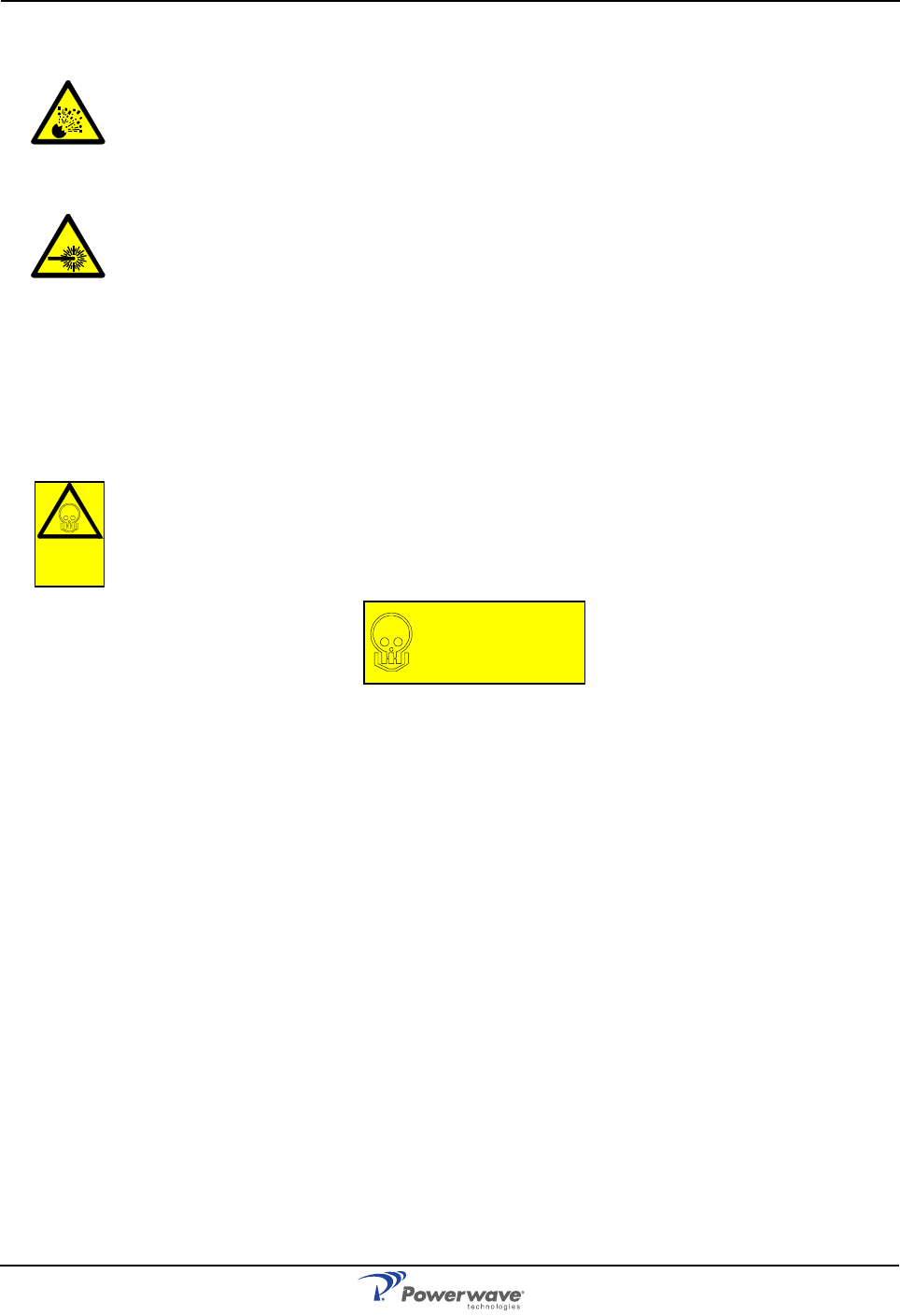User's Manual
Table Of Contents
- Revision Record
- Table of Contents
- List of Figures
- List of Tables
- Abbreviations
- Chapter 1 Product Description
- Introduction
- Scope of Manual
- Safety
- Warning Signs
- Human Exposure of RF Radiation
- Radiation Safety Distances
- Electrostatic Discharge (ESD)
- Sub Unit Overview
- Wideband Amplifier PCBA (WBA)
- Power Amplifier PCBA (PA)
- Multi-Carrier Power Amplifier PCBA (MCPA)
- Booster Amplifier PCBA (BA)
- Distribution PCBA (DIA)
- Control Unit PCBA (CU)
- Low Noise Amplifier (LNA)
- Duplex Filter (DPX)
- Fiber Optic Unit (FOU)
- Fiber Optic Node (FON)
- Power Supply Unit (PSU)
- Remote Control Unit (RCU)
- Alarm Interface PCBA (ALI) and Remote Control Interface PCBA (RCI)
- Sub Unit Locations
- Fiber Optic Distribution Networks
- Multi-Operator Configurations
- Chapter 2 Controls, Indicators and Connectors
- Chapter 3 Installation
- Chapter 4 Maintenance
- Chapter 5 Specifications
- Appendix A Block Diagrams

Wideband Radio Head Safety
1-2 044-05251 Rev A
coaxial cable insulation. No particular measures are to be taken in case of fire because
the emitted concentration of hydrogen fluoride is very low.
• A lithium battery is permanently mounted on CU units, and in FON and OCM units. Due
to the risk of explosion, this battery must only be removed from the board by an
Powerwave authorized service technician.
• NiCd batteries are mounted on the FON unit. These batteries contain environmental
poisonous substances. If replaced, the old batteries should be taken care of as stated
in the local prescriptions.
• The FON unit contains a class IIIb laser transmitter that emits 2 – 4mW invisible laser
radiation during operation. Avoid direct exposure from unconnected laser transmitter or
fiber cord as follows:
– Do not power up the FON unit if a fiber cable is not attached to the fiber output UL
port, neither if a fiber cable is attached to the port but unattached in the other end.
– Never look in the end of a fiber cable. The 1310nm and 1550nm laser light is not
visible, so no signal identification can be made anyway. Use always an instrument,
such as a power meter to detect signaling.
– Never use any kind of magnifying devices that can focus the laser light to an
unaided eye.
Warning Signs
The following warning signs must be observed and be kept clean and readable.
Beryllium oxide
This warning sign is applied on boards and units which contain beryllium oxide parts.
This warning sign is applied at the bottom, inside the cabinet, below the power supply unit.
Human Exposure of RF Radiation
Safe distances must be kept when working around antennas. The following paragraphs
describe the cautions to be aware of during the installation and maintenance of antenna
systems and how to calculate safety distances needed for RF radiation at different antenna
power and frequencies.
Antennas
To be able to receive and transmit signals, a WRH is connected to a donor antenna directed
towards the base station and a service antenna directed towards the coverage area. A fiber
optic cable from the base station might, however, be substituted for the donor antenna.
Installation and Maintenance of Antenna Systems
Installation and maintenance of all antenna systems must be performed with respect to the
radiation exposure limits for public areas. The antenna radiation level is affected by WRH
output power, antenna gain, and transmission devices such as cables, connectors, splitters
and feeders. Also have in mind the system minimum coupling loss, typically between 25dB and
35dB, is determined by a standard with the purpose to protect base stations from noise and
other performance dropping effects.
Radiation Exposure
The World Health Organization (WHO) and International Commission on Non-Ionising
Radiation Protection (ICNIRP) have determined recommendations for radiation exposure.
ICNIRP recommends not to exceed the following radiation power for public exposure:
Beryllium
oxide
hazard
BERYLLIUM OXIDE
(Toxic)
used in equipment
see instruction boo
k










